The number of international migrants grew to 281 million in 2020, meaning that 3.6% of the world’s people lived outside their country of birth that year, according to the United Nations’ International Organization for Migration (IOM). The increase came despite widespread restrictions on travel and international movement in the early stages of the coronavirus pandemic.
Here are eight key facts about international migrants, based on the latest available data from the UN and other sources.
Pew Research Center conducted this analysis to better understand trends in global migration and remittances, or the money that migrants send back to their home countries.
Data on the number of international migrants comes from the 2020 International Migrant Stock datasets from the United Nations. Data on the number of refugees, asylum seekers, internally displaced people and other globally displaced Venezuelans comes from the UN’s World Migration Report 2022. The total population estimates for countries and regions used to calculate ratios and percentages for charts come from the UN’s 2022 World Population Prospects dataset. Intraregional migration data for Latin America comes from the International Organization for Migration regional office for South America and Central America, North America and the Caribbean.
To examine changes in monthly remittances during the COVID-19 pandemic, this analysis uses global estimates of remittance flows from the World Bank.
The UN uses a taxonomy of regions, nations and territories that counts those who were born in Puerto Rico and are living in the 50 states or the District of Columbia as international migrants to the U.S., even though they are U.S. citizens by birth. For this reason, some UN estimates of the foreign-born population shown here may differ from other estimates published by the U.S. Census Bureau or Pew Research Center.
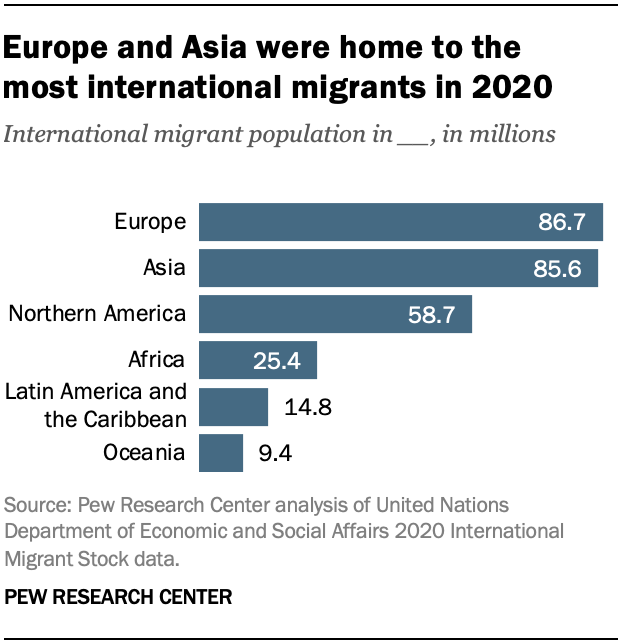
Europe and Asia have the most international migrants. An estimated 86.7 million international migrants lived in Europe in 2020, followed by 85.6 million in Asia. The number of international migrants living in these two regions has steadily increased since 2005, according to the IOM.
The Latin America and Caribbean region has the fastest-growing international migrant population. Since 2005, the region’s international migrant population has roughly doubled.
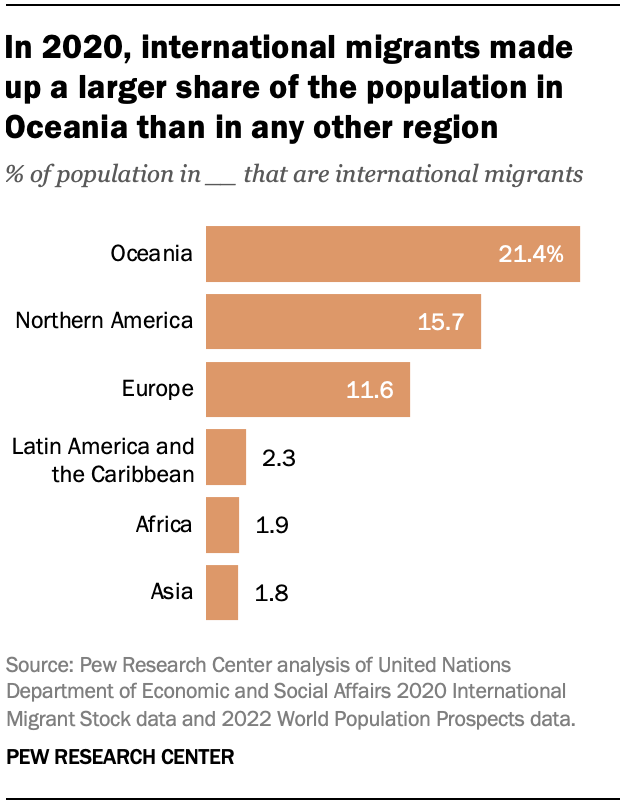
International migrants make up a larger share of Oceania’s population than any other region. In 2020, 21.4% of all residents in Oceania – which includes Australia, New Zealand and various Pacific island nations and territories – were international migrants. The Northern America region is second after Oceania, with migrants making up 15.7% of the population. In Europe, migrants account for 11.6% of the population. In all other world regions, they represent 2.3% or less of the population.
Using other regional groupings, however, Oceania might be surpassed. For example, in Gulf Cooperation Council countries – Bahrain, Kuwait, Oman, Qatar, Saudi Arabia and the United Arab Emirates – more than half (52.7%) of resident populations are international migrants, according to UN data.
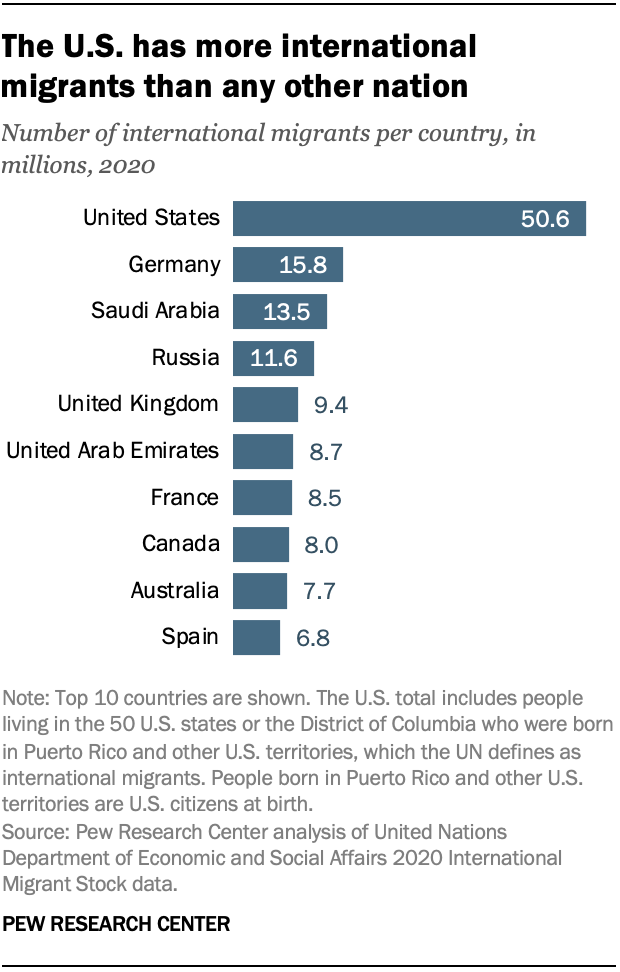
The United States has more international migrants than any other country. With nearly 51 million migrants in 2020, the U.S. leads the world on this measure by a wide margin. Germany has the next-largest such population with about 15.8 million migrants, followed by Saudi Arabia with 13.5 million. (For the U.S., the UN counts some people living in the 50 states or the District of Columbia as international migrants even if they were born in Puerto Rico or other U.S. territories; those born in Puerto Rico and other U.S. territories are U.S. citizens at birth.)
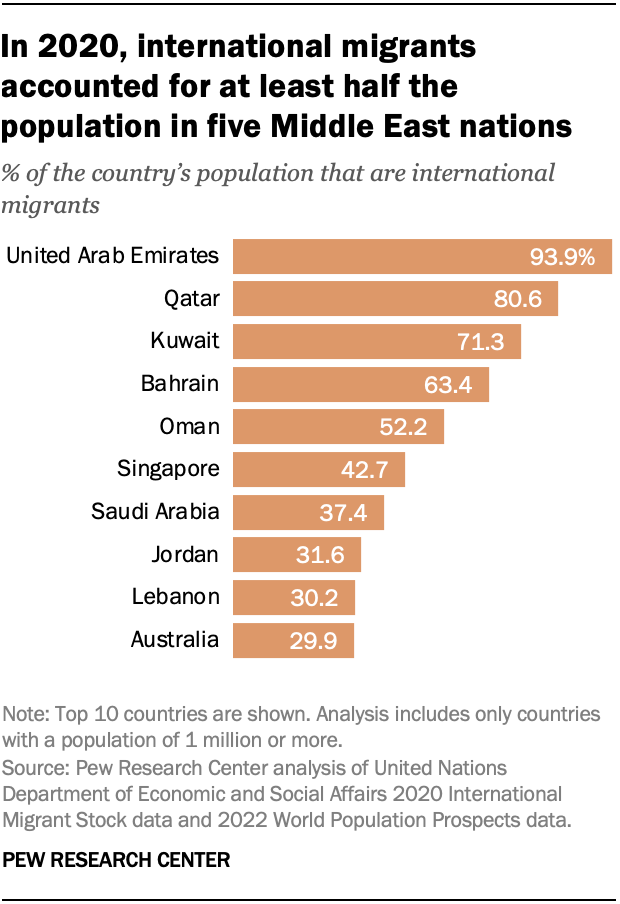
The countries that have the most international migrants are generally not the same countries where international migrants make up the greatest share of the population. For example, while the U.S. has more migrants than any other nation, migrants only account for about 15.1% of the U.S. population – a smaller share than in 24 countries or territories with a total population of at least 1 million.
The Middle East accounts for most of the top 10 countries when looking at the migrant share of the population. In 2020, 93.9% of all people living in the United Arab Emirates were international migrants, followed by 80.6% of people in Qatar and 71.3% of people in Kuwait. Other Middle Eastern countries among the top 10 include Bahrain, Oman, Saudi Arabia, Jordan and Lebanon.
India remains the top origin country for the world’s migrants. India has been a large source of international migrants for more than a century. In 2020, 17.9 million international migrants traced their origins back to India, followed by Mexico with about 11.2 million and Russia with about 10.8 million.
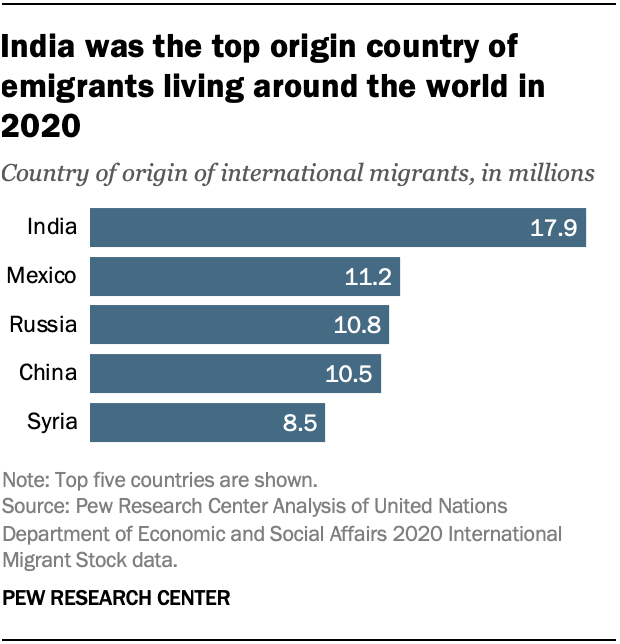
India’s migrants are dispersed around the world, but the countries with the largest Indian migrant populations are the United Arab Emirates (3.5 million), the U.S. (2.7 million) and Saudi Arabia (2.5 million).
Though India is the single largest source of international migrants, its 17.9 million migrants in 2020 accounted for only 1.3% of all people born in India by that year. By comparison, the United Kingdom’s 4.7 million international migrants accounted for 7.6% of those born in the UK by 2020. Mexico’s 11.2 million international migrants accounted for 8.2% of those born in Mexico.

Remittances – the money that migrants send to their home countries – decreased by about $11 billion from 2019 to 2020 as the coronavirus pandemic arrived. Global remittances had been steadily increasing since 2010, but they fell from $722 billion in 2019 to $711 billion in 2020. (These figures are nominal values, meaning they are not adjusted for inflation.) Notably, some countries in Latin America saw remittances fall sharply in the first half of 2020 – especially in April, when much of the U.S. was locked down due to the COVID-19 outbreak – before rebounding.
According to the World Bank, remittances reached $781 billion in 2021 and are estimated to reach $794 billion in 2022, both record highs.
India has been the world’s top receiver of remittances since 2010. Remittances to India grew from $53 billion in 2010 to $89 billion in 2021.
The U.S. has been the top sending country for remittances since 1990, the earliest year with available statistics. In 2021, international migrants living in the U.S. sent $73 billion in remittances globally.
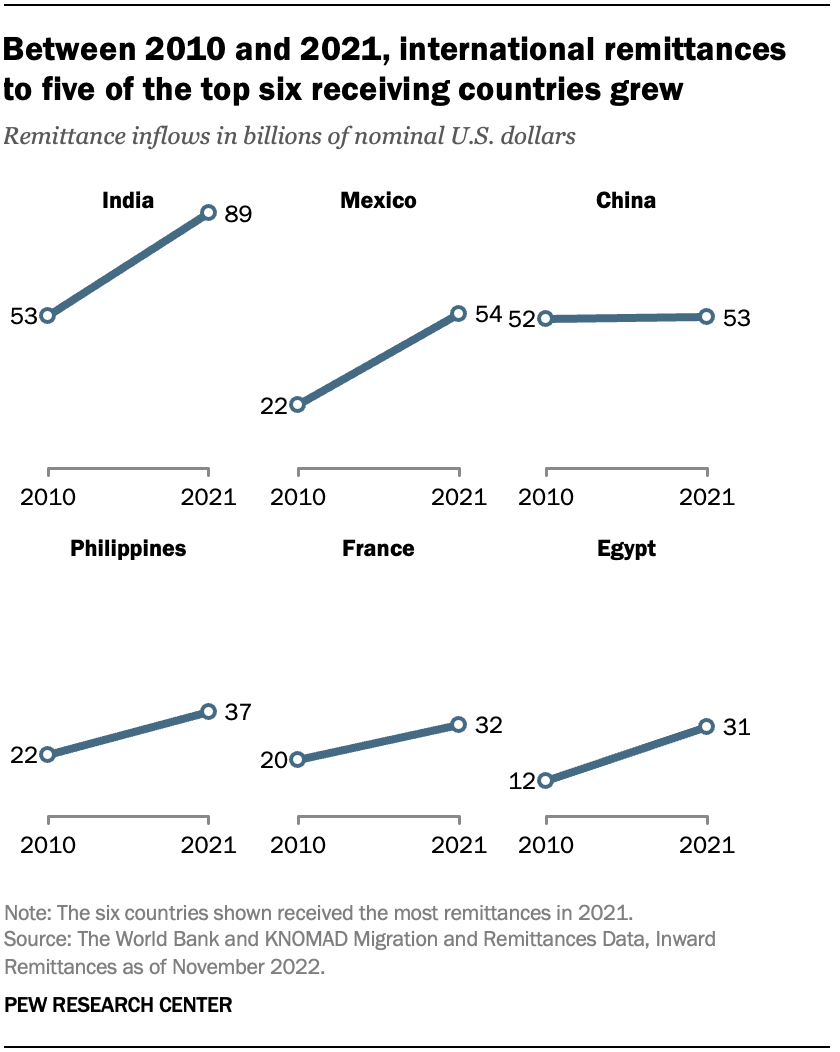
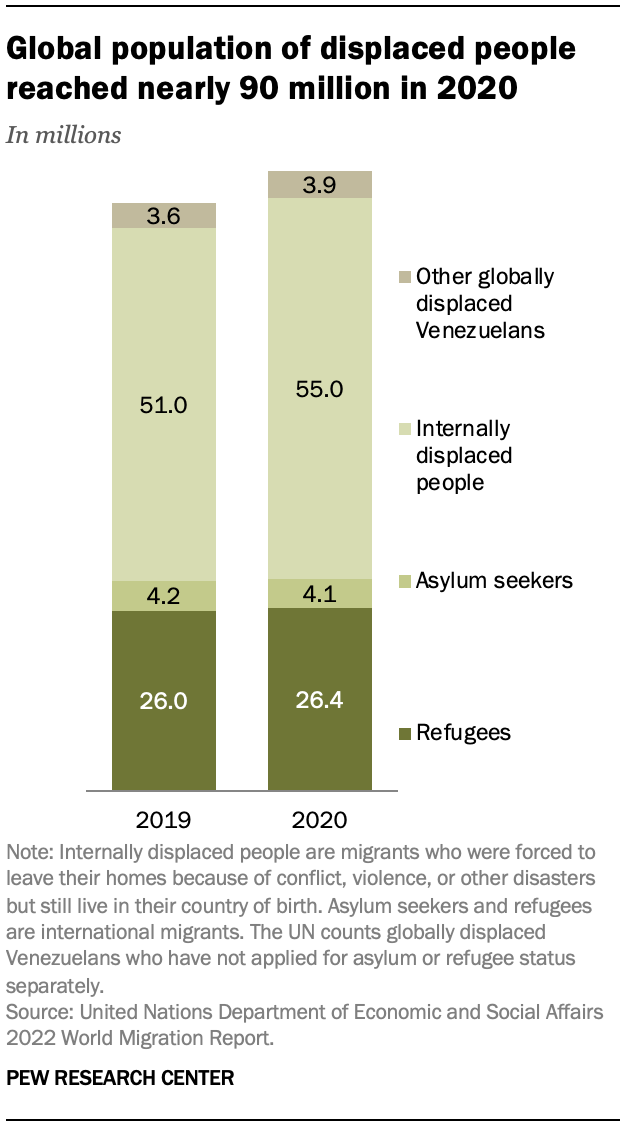
The number of displaced people in the world rose to a new high of 89.4 million in 2020. Displaced people are those forced to leave their homes due to conflict, violence or disasters. They include refugees, asylum seekers, and people internally displaced within their country of birth. Overall, the number of displaced persons rose from 84.8 million in 2019 to 89.4 million in 2020, according to the UN’s World Migration Report 2022. Overall, about 1.1% of the world’s population are displaced people.
Among the world’s displaced people, about 34%, or 30.5 million, were living outside their country of birth as refugees (26.4 million) or asylum seekers (4.1 million) in 2020. An additional 3.9 million displaced Venezuelans who have not applied for refugee or asylum status lived outside of Venezuela in 2020. The majority of displaced people, 55 million, were internally displaced in their birth countries because of conflict, violence or disasters.
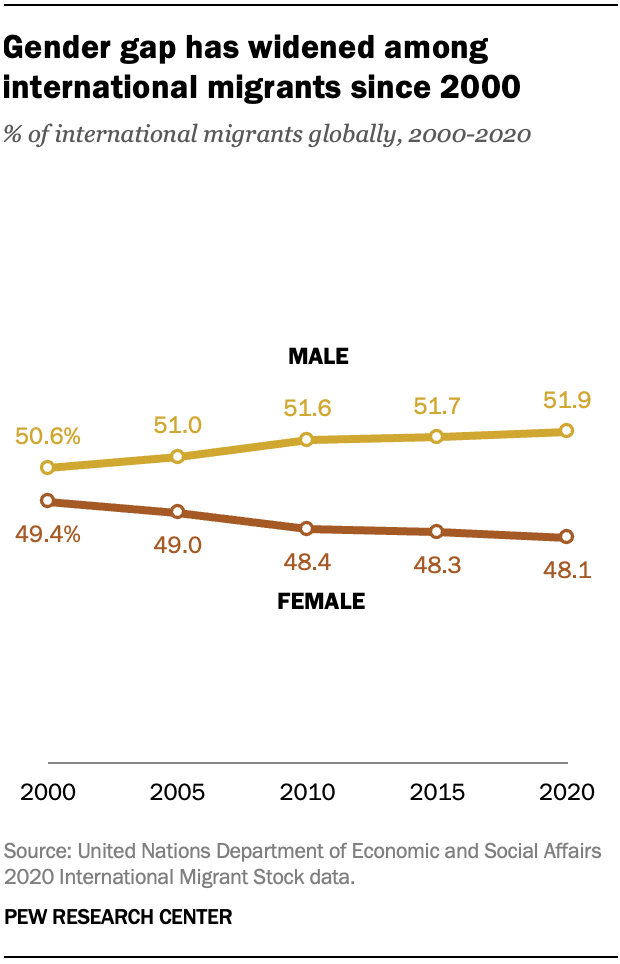
The share of international migrants who are men has ticked up in recent decades. In 2000, 50.6% of international migrants were men and 49.4% were women. By 2020, men made up 51.9% of global migrants while 48.1% were women, according to estimates by the United Nations.
A majority of the world’s international migrants lived within their region of origin in 2020. While some migrants may go to new regions of the world, a majority (54.9%) lived within their region of origin in 2020. However, international migration within regions still varies widely. For example, 69.9% of Europe’s international migrants resided in another European country in 2020, reflecting migration out of Eastern European countries such as Russia, Ukraine, Poland and Romania to Western European ones.
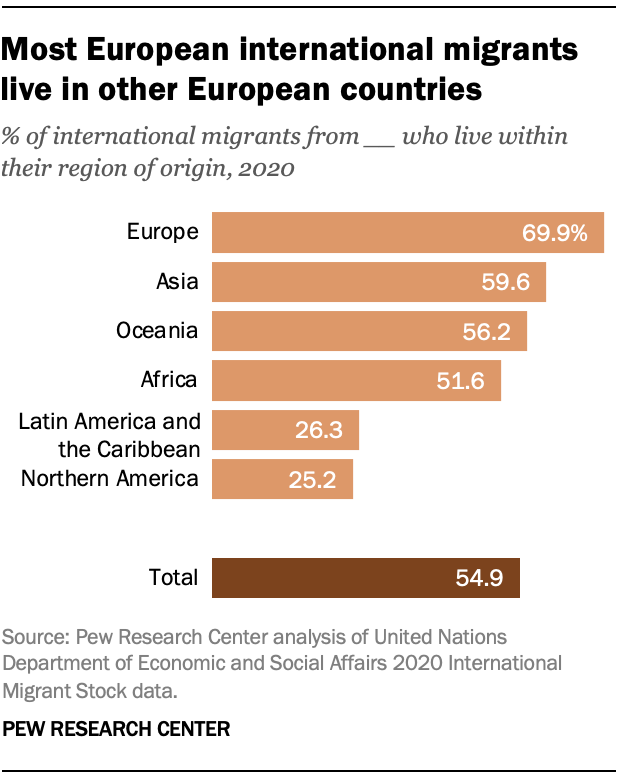
International migrants in Asia and Oceania are the next most likely to live in their region of origin at 59.6% and 56.2%, respectively. Migrants from Africa are about as likely to live within Africa as they are to live outside of the continent (51.6% vs. 48.4%).
Migrants from Latin America and the Caribbean, as well as the Northern America region, are the least likely to live within their region of origin, at 26.3% and 25.2%, respectively.
Note: Here is the UN’s list of countries and territories grouped by region.




